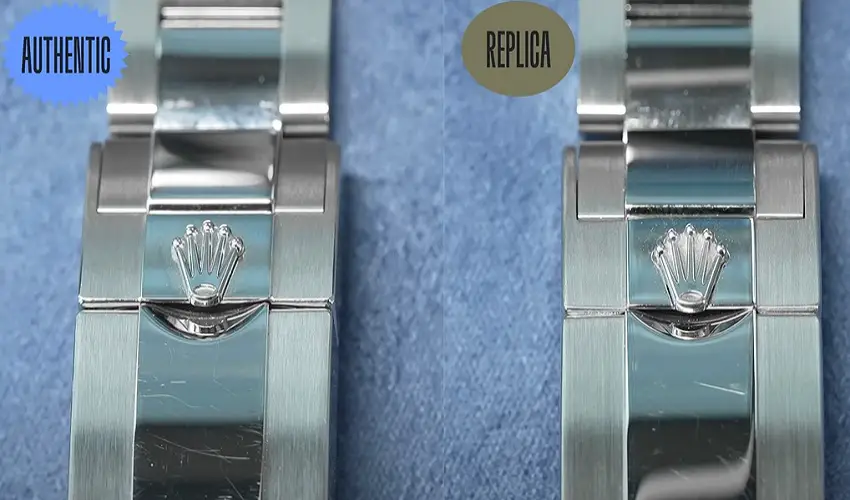Real Rolex clasps are made of high-quality, durable materials and have precise, intricate details, while fake clasps often have imperfections and are made of lower-quality materials, making them lighter and less sturdy. The differences in quality, weight, and detailing are key indicators of a real versus fake Rolex clasp.
When it comes to authenticating a Rolex watch, one of the key elements to look at is the clasp. The clasp of a Rolex watch should be a reliable and secure mechanism that ensures the watch stays comfortably and securely on the wrist.
However, there are differences between real and fake Rolex clasps that can help you determine the authenticity of a Rolex watch. Understanding these differences can be crucial when purchasing a pre-owned Rolex or when verifying the authenticity of a new purchase.
We’ll explore the key differences between real and fake Rolex clasps so that you can make an informed decision when buying or authenticating a Rolex watch.
Understanding Rolex Clasp
Types Of Rolex Clasps
A Rolex watch is renowned for its precision, craftsmanship, and attention to detail, including the clasp, an essential component that secures the timepiece to the wrist.
There are several types of clasps used in Rolex watches, each with its unique design and function.
- Oysterclasp: The Oysterclasp features an elegant and robust design, providing a secure closure for the watch.
- Crownclasp: This type of clasp is characterized by its discreet and refined appearance, allowing for seamless integration with the overall design of the watch.
- Glidelock clasp: Designed for the Oyster Perpetual Submariner and Sea-Dweller models, the Glidelock clasp offers incremental adjustments without the need for tools, ensuring a comfortable fit in any situation.
Function Of The Clasp
The clasp of a Rolex watch serves a vital function, not only in securing the timepiece to the wrist but also in enhancing the overall wearing experience. It ensures that the watch stays in place while offering ease of use when putting it on or taking it off, contributing to the longevity of the timepiece.
Key Features Of A Genuine Rolex Clasp
Genuine Rolex clasps exhibit specific features that set them apart from fake counterparts. Here, we delve into the essential attributes of a authentic Rolex clasp.
Material And Craftsmanship
A genuine Rolex clasp is meticulously crafted from high-quality materials, such as solid stainless steel or 18k gold. The finish is precisely executed, with smooth edges and flawless surface texture.
Logo And Engravings
The Rolex logo on a genuine clasp is clean and sharp, with fine detailing that is often lacking in counterfeit versions. Engravings, such as the serial number, are clearly etched with consistent depth.
Identifying Counterfeit Rolex Clasps
Are you a proud owner of a Rolex watch or planning to buy one? Then, it’s crucial to be equipped with the knowledge of identifying counterfeit Rolex clasps. The clasp is an integral part of a Rolex watch, ensuring a secure and comfortable fit on your wrist.
A fake clasp not only compromises the overall quality of the watch but also ruins its value. In this section, we will explore the common flaws and red flags to look for when identifying counterfeit Rolex clasps.
Common Flaws
The counterfeit market is flooded with fake Rolex clasps trying to imitate the genuine ones. However, there are distinct flaws that can help you differentiate between the two. Familiarizing yourself with these common flaws will save you from falling victim to counterfeit clasps.
Let’s take a look:
- Material Quality: Counterfeit clasps are often made from inferior materials that lack the durability and fit of genuine Rolex clasps.
- Poor Craftsmanship: Pay close attention to the finishing and details. Counterfeit clasps usually exhibit sloppy craftsmanship and lack the fine precision of genuine ones.
- Lack of Rolex Markings: Genuine Rolex clasps bear the iconic Rolex crown logo and the Rolex name. Counterfeit clasps may have misspellings or inaccurate Rolex markings.
- Weight: The weight of a genuine Rolex clasp is noticeably heavier due to the high-quality materials used. Counterfeit clasps may feel lighter and flimsy.
Red Flags To Look For
When inspecting a clasp to determine its authenticity, keep an eye out for these telltale red flags:
- Mismatched Serial Numbers: Every genuine Rolex clasp has a unique serial number engraved on it, which matches the serial number on the watch case. If the numbers don’t align, it’s a clear indication of a counterfeit clasp.
- Inaccurate Logo and Font: Counterfeit clasps often have inconsistencies in the Rolex logo, font style, and spacing. Genuine Rolex clasps maintain a consistent and precise logo and font.
- Unsatisfactory Movement: Genuine Rolex clasps boast smooth and precise movement when opening and closing. Counterfeit clasps may exhibit jerky or uneven movement.
- Price Discrepancies: If a deal sounds too good to be true, it probably is. Counterfeit clasps are often priced significantly lower than authentic ones. Be wary of suspiciously low prices.
Becoming familiar with these common flaws and red flags will enable you to confidently authenticate Rolex clasps, ensuring that you invest in only genuine and high-quality pieces. Safeguard your investment and enjoy the timeless elegance of a genuine Rolex watch.
Methods For Authenticating A Rolex Clasp
The clasp on a Rolex watch is an essential component that not only secures the timepiece to your wrist but also serves as a telltale sign of authenticity.
As with any luxury brand, counterfeit Rolex clasps have flooded the market, making it crucial for buyers to be able to distinguish between a real versus a fake clasp.
In this blog post, we will explore two effective methods for authenticating a Rolex clasp: using magnification and consulting authorized dealers.
Using Magnification
Examining your Rolex clasp under magnification is a valuable technique to detect any discrepancies that may indicate a potential counterfeit. Here are some key factors to consider:
- Engravings: Genuine Rolex clasps usually have precise and clean engravings, including the Rolex crown logo and reference numbers. Counterfeit clasps may have shallow or uneven engravings that don’t match the original design.
- Quality of Finish: Authentic Rolex clasps display a high level of craftsmanship, with impeccable polish and an overall luxurious appearance. Counterfeit clasps may exhibit rough edges, inconsistent coloring, or inferior metal quality.
- Serial and Model Numbers: Genuine Rolex clasps typically feature engraved serial and model numbers on the inner side. Ensure these numbers are present and precisely etched, without any smudging or irregularities. Counterfeit clasps may have poorly executed or incorrect serial and model numbers.
Remember, using magnification is an excellent way to closely examine the finer details of a Rolex clasp, but it must be used in conjunction with other authentication methods for a comprehensive assessment.
Consulting Authorized Dealers
When in doubt about the authenticity of a Rolex clasp, seeking the expertise of authorized dealers is highly recommended. These authorized dealers possess the knowledge and experience to identify genuine Rolex clasps.
Here’s how you can benefit from consulting them:
- Product Knowledge: Authorized dealers have an in-depth understanding of Rolex watches, including their clasps. They can provide expert insights on the specific characteristics and features to look for when authenticating a clasp.
- Access to Resources: These dealers have access to official Rolex resources, such as product catalogs, manuals, and reference materials. Utilizing these resources can aid in the authentication process.
- Hands-on Comparison: By visiting an authorized dealer, you can examine an authentic Rolex clasp up close and compare it to the clasp in question. This side-by-side comparison can be instrumental in identifying any discrepancies.
Consulting authorized dealers can provide you with a professional assessment and instill greater confidence in your Rolex clasp authentication process.
Case Studies Of Real Vs. Fake Rolex Clasps
Comparison Of Authentic And Replica Clasps
When evaluating Rolex clasps, it is imperative to distinguish between genuine and counterfeit versions. Here we compare the key differences:
- Material: Genuine clasps are crafted from high-quality metals like stainless steel or gold.
- Engraving: Authentic clasps feature precise and deep engravings, while replicas may have shallow or inaccurate markings.
- Weight: Real Rolex clasps are sturdy and weighty, whereas fake ones often feel lighter and less substantial.
- Mechanism: Genuine clasps exhibit smooth and precise opening and closing mechanisms, unlike replicas that may be stiff or loose.
Real-life Examples
Examining case studies of real and fake Rolex clasps can offer valuable insights into distinguishing between the two:
| Feature | Authentic Clasp | Replica Clasp |
|---|---|---|
| Material | Stainless steel or gold | Low-quality metal |
| Engraving | Precise and deep | Shallow or inaccurate |
| Weight | Sturdy and weighty | Light and less substantial |
| Mechanism | Smooth and precise | Stiff or loose |
Consequences Of Owning A Fake Rolex
Owning a Rolex has always been a symbol of luxury and status. Unfortunately, the market is flooded with counterfeit Rolex watches, making it challenging for buyers to identify authentic timepieces. The consequences of owning a fake Rolex extend beyond just a financial loss. It can lead to legal implications and tarnish your reputation.
Let’s delve into the potential ramifications of being in possession of a counterfeit Rolex.
Legal Implications
If you are found in possession of a fake Rolex, you could face legal repercussions. Counterfeiting is a serious offense and can lead to hefty fines and even jail time.
Rolex vigorously protects its brand and intellectual property rights, and they are known to take legal action against individuals or businesses involved in the distribution or sale of counterfeit Rolexes.
Therefore, owning a fake Rolex puts you at risk of legal trouble that can have long-lasting consequences.
Impact On Reputation
Besides the legal consequences, owning a fake Rolex can severely impact your reputation. Whether you are an individual or a business, being associated with counterfeit goods undermines your credibility and integrity.
In the eyes of others, it raises questions about your ethical values and attention to detail. Additionally, if your peers or clients discover that you own a counterfeit Rolex, it may damage your relationships and ultimately harm your personal or professional reputation.
Frequently Asked Questions For Rolex Clasp Real Vs Fake
Is It Possible To Spot A Fake Rolex Clasp?
Yes, spotting a fake Rolex clasp involves examining the quality of materials, logo engraving, and overall craftsmanship.
Authentic Rolex clasps have precise details and superior finishing, while fake ones may display inconsistencies and lack the brand’s signature characteristics.
What Are The Key Differences Between Real And Fake Rolex Clasps?
Real Rolex clasps are meticulously crafted with high-quality materials, intricate detailing, and smooth functionality.
On the other hand, fake Rolex clasps often feature subpar construction, inaccurate engravings, and inferior finishes that are noticeable upon close inspection.
How Can One Authenticate A Rolex Clasp At Home?
To authenticate a Rolex clasp at home, examine the logo engraving, weight, and overall craftsmanship.
Check for subtle details like the crown emblem’s alignment and the smoothness of the clasp mechanism.
Additionally, consider seeking guidance from authorized Rolex dealers or experts for further verification.
Conclusion
In determining authenticity, examining Rolex clasps is crucial. Real vs fake differences reveal the importance of quality. Spotting these distinctions enhances your buying confidence.
Understanding these details prevents falling victim to counterfeit products. Trust your instincts and the finer details when determining the authenticity of your Rolex clasp.

